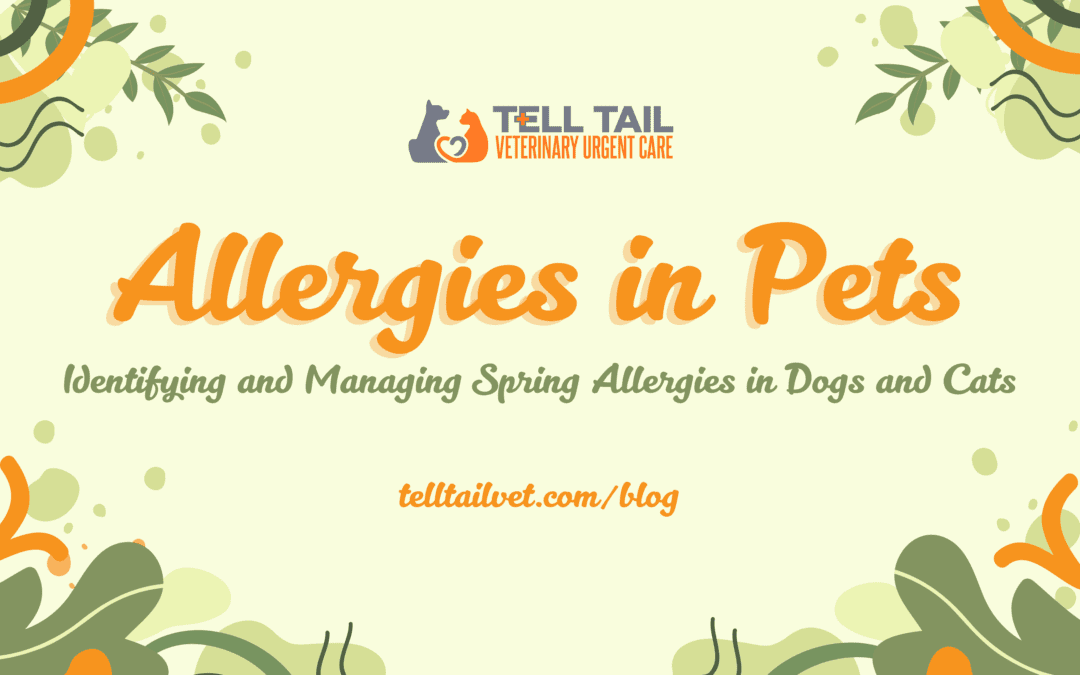Spring is a beautiful time of year, but for many pets, it also brings the misery of seasonal allergies. Just like humans, dogs and cats can suffer from pollen, mold, and other environmental allergens, leading to uncomfortable symptoms. If your pet starts itching, sneezing, or experiencing other allergy-related issues as the seasons change, here’s what you need to know about identifying and managing spring allergies.
Common Signs of Spring Allergies in Pets
Seasonal allergies in pets can manifest in several ways. Keep an eye out for these common symptoms:
-
Excessive Scratching or Licking – Persistent itching, especially around the paws, ears, belly, and face, is a major sign of allergies.
-
Red, Inflamed Skin – Allergic reactions often cause redness, irritation, or hot spots.
-
Ear Infections – Recurring ear infections or excessive head shaking may indicate allergies, especially in dogs with floppy ears.
-
Watery Eyes and Sneezing – Just like in humans, seasonal allergens can cause eye discharge and frequent sneezing.
-
Hair Loss or Skin Sores – Chronic itching can lead to bald patches, scabbing, or sores.
-
Paw Chewing or Red, Swollen Paws – Allergens can collect on a pet’s paws, leading to irritation and excessive licking.
If you notice these symptoms returning around the same time each year, seasonal allergies could be the culprit.
Common Spring Allergy Triggers
Pets can develop allergies to a variety of environmental factors, including:
-
Pollen from Trees, Grass, and Flowers – Carried in the air and easily tracked indoors, pollen is one of the most common spring allergens.
-
Mold and Mildew – Increased moisture in the air can encourage mold growth, which can trigger allergic reactions in pets.
-
Dust and Dander – Spring cleaning can stir up allergens that have settled in carpets, furniture, and air vents.
-
Insect Bites – Fleas and other biting insects can cause allergic reactions in sensitive pets.
Managing Seasonal Allergies in Pets
While allergies can’t always be cured, there are several ways to reduce your pet’s discomfort and limit their exposure to allergens.
Minimize Allergen Exposure
-
Wipe Down Your Pet After Outdoor Time – Use a damp cloth or pet-safe wipes to clean their paws and fur after walks to remove pollen and other allergens.
-
Bathe Regularly with Hypoallergenic Shampoo – A soothing oatmeal or medicated shampoo can help reduce itching and wash away allergens.
-
Vacuum and Wash Pet Bedding Frequently – Keeping your home as allergen-free as possible can help reduce symptoms.
-
Use an Air Purifier – HEPA filters can help remove airborne allergens from your home.
Soothe Skin and Reduce Itching
-
Omega-3 Fatty Acids in Diet – A well-balanced diet with omega-3s can support healthy skin and reduce inflammation.
-
Cool Compresses or Oatmeal Soaks – These can provide temporary relief for irritated skin.
Monitor for Secondary Infections
Chronic scratching can lead to skin infections. If you notice open sores, excessive redness, or a bad odor from your pet’s skin or ears, they may need veterinary care to prevent further complications.
When to Seek Veterinary Care
If your pet’s allergies seem severe or are interfering with their quality of life, it’s best to consult a veterinarian. They may recommend prescription-strength allergy relief options or additional testing to determine the exact cause of your pet’s allergies.
Spring allergies can be frustrating, but with the right management strategies, you can help keep your pet comfortable and happy throughout the season. By minimizing exposure to allergens and addressing symptoms early, you can ensure that springtime is enjoyable for both you and your furry friend.


